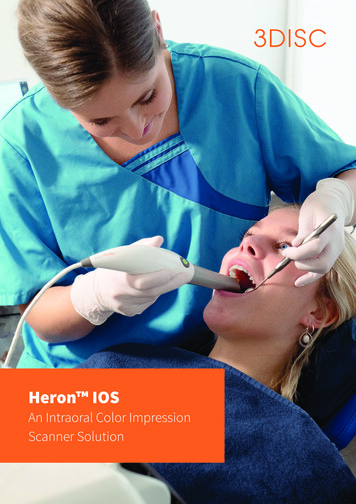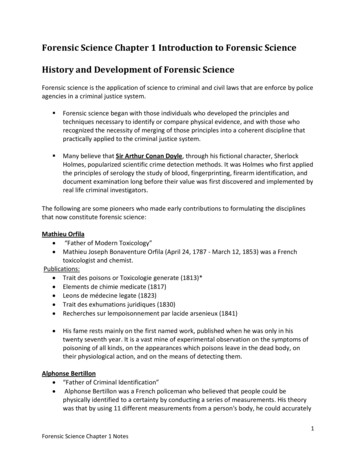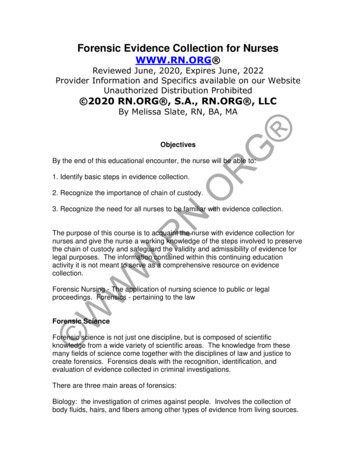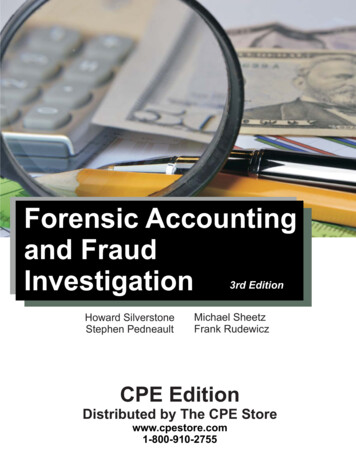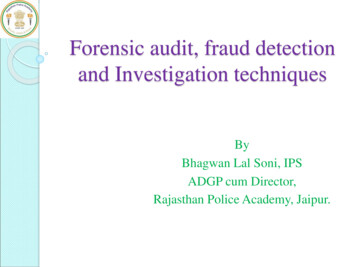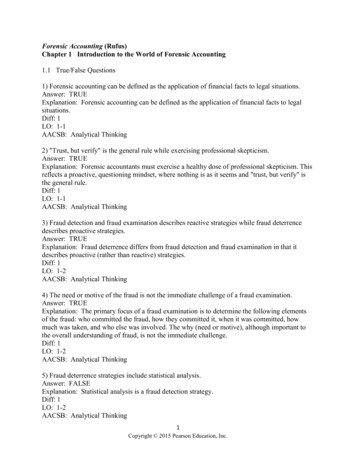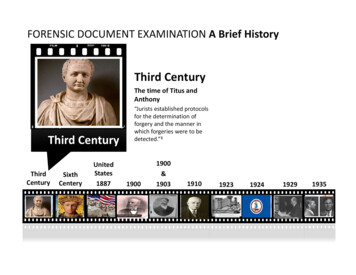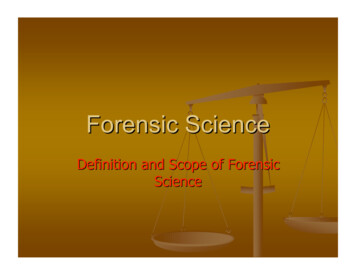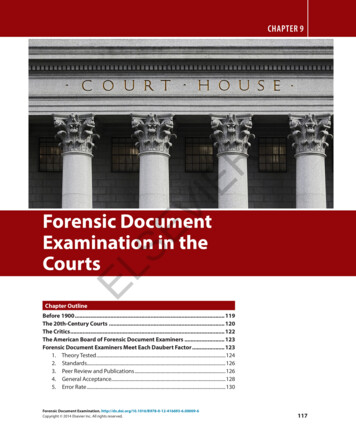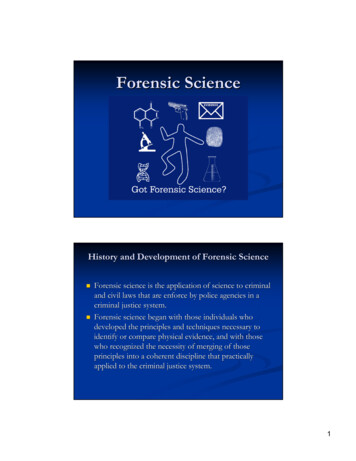
Transcription
Footwear Impression as Forensic Evidence – Prevalence,Characteristics and Evidence ValueDepartment of Mathematics, Linköping UniversityÅsa Johansson, Teresé StattinLITH – EX – MAT – – 07/15 – – SEExamensarbete: 30 hpLevel:DExaminer:Anders NordgaardDepartment of Computer and Information ScienceLinköping UniversitySupervisor:Anders NordgaardNational Laboratory of Forensic ScienceLinköping, SwedenLinköping:April 2008
2
Avdelning, InstitutionDatumDivison of Mathematical Statistics2008-04-25Department of Mathematics581 83, Linköping, SwedenSpråkRapporttypISBNSvenskax Annat (ange nedan)Licentiatavhandlingx ExamensarbeteC-uppsatsD-uppsatsISRN LITH – MAT – EX – – 07/15 – – SEEngelskaSerietitel och serienummerISSNÖvrig rapportURL för elektronisk versionhttp://urn.kb.se/resolve?urn urn:nbn:se:liu:diva-11805TitelFootwear Impression as Forensic Evidence – Prevalence, Characteristics and Evidence ValueFörfattareÅsa Johansson, Teresé StattinSammanfattningThe Forensic Science comprises a variety of sciences that are applied in order to assist and answer questions of interest tothe legal system. Since the end of the 18th century footwear impression comparison has been applied to assist in crimeinvestigations. By examining the characteristics of a footwear impression the forensic scientist may provide theinvestigator with valuable information about the footwear and sometimes even about the wearer. Ultimately, the footwearimpression is so unique that it can be individualized and identified to a specific shoe.In order to facilitate and improve the forensic evidence evaluation it is of great interest to statistically establish theprevalence of evidence. By collecting data of outsole patterns and then recording it in a database the strength of a specificfootwear impression can be determined. In this survey 687 impressions were randomly collected and recorded in avisualised database classification system, SIMSALAPIM , whereupon a statistical evaluation was performed.The result of this survey indicates that a specific outsole pattern typically only occurs once in the database, wherefore itcan be stated that any footwear impression provides some strength/value as forensic evidence even though there are noindividual characteristics present. Moreover, through additional statistical evaluations, a relation between age and shoetype also was revealed.NyckelordFootwear impression, forensic, evidence value, survey, data bases3
4
AbstractThe Forensic Science comprises a variety of sciences that are applied in order to assist andanswer questions of interest to the legal system. Since the end of the 18th century footwearimpression comparison has been applied to assist in crime investigations. By examining thecharacteristics of a footwear impression the forensic scientist may provide the investigatorwith valuable information about the footwear and sometimes even about the wearer.Ultimately, the footwear impression is so unique that it can be individualized and identified toa specific shoe.In order to facilitate and improve the forensic evidence evaluation it is of great interest tostatistically establish the prevalence of evidence. By collecting data of outsole patterns andthen recording it in a database the strength of a specific footwear impression can bedetermined. In this survey 687 impressions were randomly collected and recorded in avisualised database classification system, SIMSALAPIM1, whereupon a statistical evaluationwas performed.The result of this survey indicates that a specific outsole pattern typically only occurs once inthe database, wherefore it can be stated that any footwear impression provides somestrength/value as forensic evidence even though there are no individual characteristicspresent. Moreover, through additional statistical evaluations, a relation between age and shoetype also was revealed.SammanfattningDen forensiska vetenskapen innefattar en mängd olika vetenskaper som tillämpas för att biståoch besvara frågor av intresse för rättsväsendet. Skoavtrycksjämförelser har använts sedanslutet av 1700-talet för att bistå i brottsutredningar. Genom att undersöka egenskaper hos ettskoavtryck kan en forensiker ge utredaren värdefull information om skon och ibland även ombäraren. I bästa fall är skoavtrycket så unikt att det kan individualiseras och identifieras till enspecifik sko.För att underlätta och förbättra den forensiska bevisvärderingen är det av stort intresse attstatistiskt erhålla förekomsten av ett bevis. Genom att samla in data gällande sulmönster ochsedan etablera en databas kan styrkan hos ett specifikt skoavtryck fastställas. I denna studiesamlades 687 avtryck in slumpmässigt och lades in i ett visualiseratdatabasklassificeringssystem, SIMSALAPIM, varpå en statistisk utvärdering utfördes.Resultatet i denna studie visar på att ett specifikt sulmönster generellt förekommer endast engång i databasen, varför det kan sägas att ett skoavtryck tillför en viss styrka/värde somforensiskt bevis även om det inte besitter några individualiserande detaljer. Vidare, genomytterliggare statistiska utvärderingar, kunde även ett samband mellan ålder och typ av sko ses.1Shoe IMpressions Search And Linking with the Aid of a Partial IMpression5
AcknowledgementsThis master thesis would not have been accomplished without great guidance and supportfrom a number of people. Especially, we would like to thank our mentors, Jenny Elmqvist atthe Chemistry and Technology Unit at SKL, Linköping, and Anders Nordgaard, alsoexaminer, at the Forensic Document and Information Technology Unit at SKL, Linköping,and Linköping University.Thanks also to the following personnel at SKL, Linköping: Marcus Andrae at the ForensicDocument and Information Technology Unit for all expertise regarding photography andcamera equipment, Naceur Jaballah at the Administrative Unit for all data support, andLennart Jonasson at the Chemistry and Technology Unit for great notions of how to approachtechnical difficulties. Furthermore, we are very grateful to Sirkka Mikkonen, at the NationalBureau of Investigation, Crime Laboratory, in Vantaa, Finland, for providing theSIMSALAPIM system and Jan Johansson for constructing the “photo-device”.Special thanks are also to be directed to Maria Ledin at the Chemistry and Technology Unit atSKL, Linköping, and Graham Knight for eminent proofreading and to our opponents RobertJakobsson and Oscar Viberg. Not to forget, we are also very thankful to the shopping centresin Linköping who allowed the footwear impression collection and to all the participants forshowing great interest in the survey.Last, but not least, we would like to direct a special thank you to our friends and families fortheir great love and support. Without you we would not have made it!6
AbbreviationsDNA - DeoxyriboNucleic AcidBRÅ - Brottsförebyggande RådetDLK - Dustmark Lifting KitD-SLR - Digital Single Lens ReflexionE - EvidenceESDA - ElectroStatic Document ApparatusH - HypothesisHD - The suspect is the source of the questioned evidenceHP - The suspect is not the source of the questioned evidenceLR - Likelihood RatioSIMSALAPIM - Shoe IMpressions Search And Linking with the Aid of a Partial IMpressionSKL - Statens Kriminaltekniska Laboratorium7
8
Table of Contents1. INTRODUCTION.111.1BACKGROUND .111.1.1Historical.111.1.2Theoretical .121.2AIM AND OBJECT .121.3LIMITATIONS .132PRELIMINARY STUDIES 3.53.43.4.13.4.23.4.33.4.43.53.5.14PILOT STUDY .14LITERATURE STUDY.14FOOTWEAR IMPRESSION EVIDENCE .15Frequency and Durability .15Identification .15Information.16Deformation of the Surface .16Transfer of Trace or Residue Materials .17Detecting Footwear Impressions at the Crime Scene.17General Treatment .18THE RECOVERY OF FOOTWEAR IMPRESSIONS .18Photography .19Three-Dimensional Footwear Impressions .20Two-Dimensional Footwear Impressions.22THE IDENTIFICATION PROCESS .26General Guidelines .27Class Characteristics .27Individual Characteristics.28Wear Characteristics.30Characteristics Required for a Positive Identification.34EVIDENCE EVALUATION .35Evidence types .35The Strength of Evidence.36Significance Testing and Evidence Evaluation .37Bayes’ Theorem.38FOOTWEAR IMPRESSION DATABASES .40SIMSALAPIM .41MATERIALS AND PROCEDURE .444.1MATERIALS.444.2COURSE OF ACTION .444.2.1Preparatory Phase .444.2.2Collecting Data .464.2.3Establishing the Database.494.2.4Evaluating the Database .495RESULTS AND EVALUATION .505.1RESULTS .505.1.1Descriptive Comparison.505.1.2Cases .575.2EVALUATION .615.2.1Footwear Impression as Forensic Evidence .615.2.2Database .616CONCLUDING REMARKS .637PROSPECTIVES .649
8REFERENCES .658.1LITERATURE .658.1.1Books .658.1.2Papers .658.1.3Encyclopaedias .668.1.4Technical Notes .668.2VERBAL .668.3INTERNET 59.3.69.49.4.19.4.29.4.39.5FORM .67POSTER .68TABLES .69Pattern Prevalence.69Sole Pattern vs. Brand.70Age Distribution .71Age of Participants vs. Shoe Type .71Age of Participants vs. Age of Shoe.72Shoe Size Distribution of Participants .73CALCULATIONS.74Shoe Size Distribution of Participants .74χ2 .74Likelihood Calculations .76SCALE OF CONCLUSIONS AT SKL.7710
1. IntroductionThrough the centuries several trace evidence have been recognized to be of significance incrime investigations. For instance, blood, body fluids, fibres, tool impressions, tire trackimpressions and footwear impressions are some general traces that can be recovered,examined and processed as evidence. (Jackson et al., 2004)By examining a footwear impression the forensic scientist may provide the investigator withvaluable information about the footwear and sometimes even about the wearer. Thecharacteristics of an impression can, in fact, be so unique that it enables for identification witha suspect shoe. Thus, the footwear impression may be considered to be forensic evidence ofgreat significance. (Jackson et al., 2004)1.1 BackgroundForensic science is defined as the application of a variety of sciences in order to assist andanswer questions of interest to the legal system. The word forensic is a well-recognizedinternational concept that comes from the Latin word “forensis” which means forum, or dailyspeaking; public. (Nationalencyklopedin, 2007). In the Roman society ( 700 BC-400 AD) acriminal charge meant presenting the case before a group of public individuals. Both theperson accused of the crime and the accuser would perform speeches based on their side ofthe story at the forum in Rome, i.e. Latin “forum romanum”. The outcome of the case wouldbe based on the individual argumentation and delivery and, therefore, the person with the bestforensic ability would win. (Encyclopaedia Britannica, 2007)1.1.1HistoricalOver the centuries the humanity will to do justice continuously has forced the forensic scienceforward. Although, it is primarily during the last decades that it has become a key part of thelaw enforcement. Today, all criminal investigations are, in some way, assisted by the forensicscience. (Jackson et al., 2004)1.1.1.1In GeneralThe use of forensic science predates by more than 1000
a suspect shoe. Thus, the footwear impression may be considered to be forensic evidence of great significance. (Jackson et al. , 2004) 1.1 Background Forensic science is defined as the application of a variety of sciences in order to assist and answer questions of interest to the legal system
